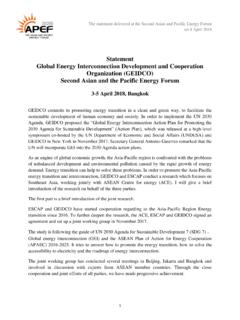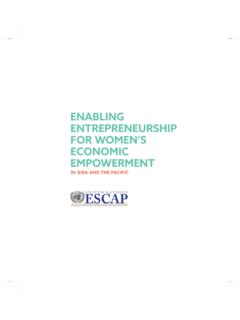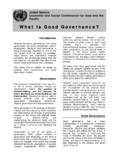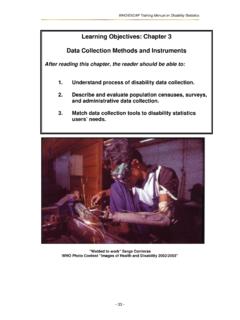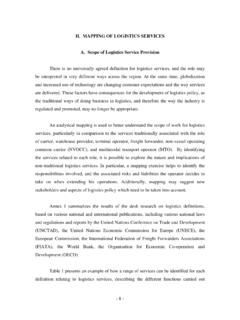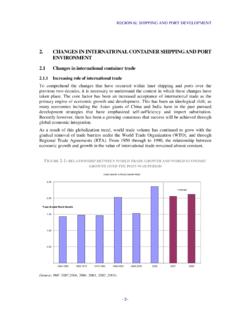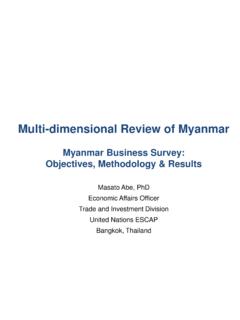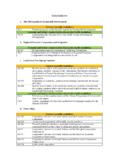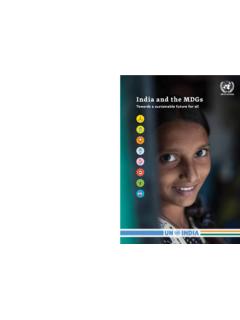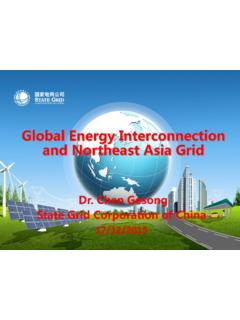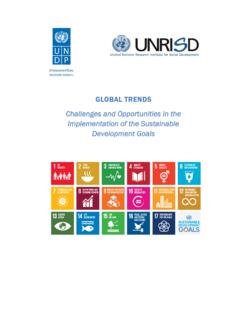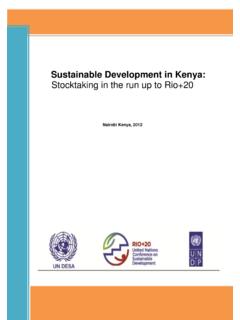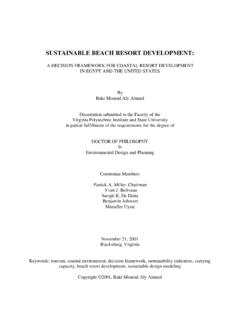Transcription of Sustainable Urban Development Policies and Initiatives
1 Sustainable Urban Development Policies and Initiatives : Perspective of NUP 2007 and NUDS 2014 Mahendra Subba, Ministry of Urban Development (MoUD) Urbanization Pattern 01020304050607019711981199120012011 EasternCentralWesternMid-WesternFar-West ern% DISTRIBUTION OF Urban POPULATION Urban Externalities Contribution to GDP: 35% of GDP is generated from the municipalities and 30% comes from the VDCs in proximity to and served by these municipalities. Generation of Tax income: Total tax revenue is of GDP, compared to total government expenditure of of GDP (more than 50% of gov. expenditure is raised through tax) Urbanization is occurring at the cost of environment, where Urban sprawl, unplanned Development , infrastructure deficit and environment degradation are common features of the Urban centers.
2 Policy Perspective: National Urban Policy, 2007 Urban System: Balanced national Urban structure that strengthens a self sustained Development region. Urban Development : Compact Urban form guided by Sustainable use of natural resources Land classification delineating Urban promotion and nature conservation zone Land use and transportation Coordination Economic dev based on local potential and comparative adv Mainstreaming informal sector economy Housing and income generation programs for Urban poor and EWS Physical Econ. Social Policy Internalization: UEMG, 2011 Urban Environment Management Guidelines, 2011 Balance between Urban Development efforts and environment Solid and hazardous waste management Pollution minimization: Air, Noise, Water, Visual Water provisioning and its quality Energy consumption reduction Green, open space and agricultural land conservation Conservation of cultural heritage Efficient Urban management Policy Internalization: NUDS, 2014 (Draft) Urban Development Urban FINANCE Urban GOVERNANCE Urban INVESTMENT Urban LAND Urban SYSTEM Urban INFRASTR.
3 Urban ENVIRONMENT Urban ECONOMY INCLUSIVITY SUSTAINABILITY RESILIENCE GREEN (asset & technology) EFFICIENCY (in service delivery) National Urban Development Strategies (NUDS) aspires to attain a qualitative vision for future cities Policy Internalization: NUDS SUSTAINABILITY Environmental: Urban Development Initiatives that is environmentally sensitive Social: Nurturing and building of social capital for vibrant social life Economic: Economic activities emphasizing on local potential and resources in a self-sustained system Strategies outlined seek to promote environmental, social and economic sustainability in Urban Development NUDS: Infrastructure and Sustainability Approach: Sustainable deliverance of basic infrastructure services in all Urban areas, an important factor that supports Urban Development Clustered city approach with concept of shared infrastructure that reduces cost and helps in efficient management of available resources Components: Rain water harvesting and recharge embedded in building regulation 3R (reduce, reuse, recycle) system practiced at HH and community level Coordination of land use and transportation Promotion of public vehicle and non-motorized form of transportation Support energy efficient building design and construction Promote optimal use of solar energy in all purpose NUDS: Environment and Sustainability Approach.
4 Physically aesthetic and safe, socio-culturally vibrant and inclusive and ecologically balanced Urban environment Physical Environment: Improve environment in meeting standards of air, land, water and noise pollution Build safe and resilient cities Natural Environment: Promotion of Urban agriculture and forest in Urban areas. Social Environment: Promotion and maintenance of open/green space Build safe and secure public spaces and neighborhoods Nurture and induce art, architecture and culture as major aspect Community participation especially of youths in Urban Development NUDS: Economy and Sustainability Approach: Productive and vibrant Urban economy with a quality of growth that creates wealth and employment opportunities Components: Building competitiveness based on the local and regional comparative advantages that helps in creating self-sustained economic system Urban regeneration of historic core areas, tied with local economy to sustain and promote local/traditional skills and resources Mainstreaming of informal Urban economy that maximizes potential of economic growth of the Urban centres The Government Program aims to: Improve basic Urban infrastructure services Build municipal capabilities in Urban and resource mapping, Comprehensive Financial Improvement & Management Plan, infrastructure planning program underway (since 2003) through investment from the Government, ADB and WB 2.
5 9 municipalities supported, 16 more are being supported with investment of USD 250 mil. 3. Pilot activities (solid waste OBA, waste-to-energy) underway LESSONS arrangement for project implementation is complex of metropolitan framework for municipal solid waste ROADBLOCKS to improve the revenue base of municipalities? should be the financing model for these municipalities? to arrive at the consensus for resource sharing & management for infrastructure facilities at the regional level? KNOWLEDGE GAPS Sustainability Initiatives : UEIP Urban Environment Improvement Program Initiatives : LTDPKV, 2020 Long Term Development Plan, 2002-03: Urban -Rural delineation line seeks to contain Urban sprawl and conserve peripheral natural resources. Seeks to channel new Development to strategically located Development nodes for preservation of agricultural land.
6 Initiatives : KSUTP, 2010 Public Transport 1 Traffic Management 2 Operator and Route Rationalization Operation of routes by appropriate vehicles New and improved bus interchanges Improve in traffic junctions and signals Prioritization of pedestrian movement Kathmandu Sustainable Urban Transport Project Pedestrianization 3 Air Quality 4 Emission tests strengthened and enforced Promotion of zero emission vehicles Pedestrianization of historic core Improve access and safety for pedestrian Initiatives : BUTPM, 2012 Biratnagar Urban Transport Planning and Management: Review existing plans and strategy of Urban Development Develop long term vision and goals for Urban transport and land-use implementation plan Performance Monitoring System Comprehensive Urban transport and land use strategy Unit for Urban transport planning and management Prepare guidelines and toolkits on public transport services, Urban transport infrastructure management Institutional Enhancement Strengthened capacity in planning and management for Sustainable Urban transport Initiatives : Periodic Planning Planning Methods.
7 Hybrid (in content) Participatory inclusiveness (in process) Environment pro-activeness (in aspiration) Social Inclusive Urban growth that involves marginalized and differently-abled groups Environment Land classification discouraging Urban dev. from environmentally sensitive areas Economy Unleashing local potential and mobilizing local resources Bhadrapur PP Skill Development program for differently-abled people Capacity Development program for disadvantaged groups Agricultural processing industry; market management and promotion ; Tourist spots Development Integrated solid waste management; tree plantation program GESI Guideline for increased access of women, poor and excluded (WEPs) communities to Urban Development resources and its benefits.
8 Initiatives : GESI, 2013 Major Initiatives : Establishment of Social Coordination Section in the Ministry. Establishment of Social Coordination Section within sectoral departments to oversee works of both WASH and HUB sectors. Establishment of GESI Units within regional, district as well as project offices of the departments. Pro-poor Urban Regeneration Project aims to: Improve infrastructure and services Conserve local cultural heritage Increase access to income generating opportunities in cultural industries Initiatives : PPURP, 2013 Economic dimension: An integrated regeneration approach that is tied to local economy by creating jobs for poor through cultural industries by harnessing local and traditional craftsmanship. Challenges Environment, social and economic dimensions of sustainability not adequately integrated in Urban planning and Development and implemented Need of guidelines and tool kits to be practiced and operationalized for planning vis- -vis at project level Need to develop performance measure indicators Inadequate institutional capacity and co-ordination mechanisms Need of a collaborative governance, involving multi-sectoral approach to deal with Urban issues at all levels of Development cycle Challenges Qualitative Development instead of quantitative growth need emphasis Technological use and innovation in transportation, information, and industry is imperative.
9 Hence, these perspectives in city planning and Development must be built. Building knowledge system making research a basis for policy input. Forging a Public Private Academia Partnership (PPAP) Thank you!
